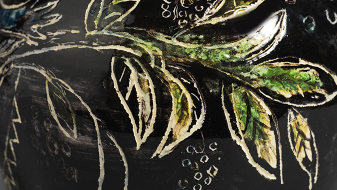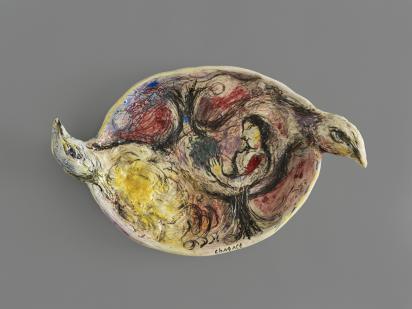Chagall created Two Birds more than ten years after he began working with ceramics. It is the only example of a sculpture-dish he ever made. Drawing on his experience, and with help from the Madoura studio’s artisans, he sought to push the medium’s limits as far as they could go. After a series of vase-sculptures that began with Elijah’s Chariot in 1951, he continued his quest for new forms by subverting the shapes of functional objects. Here, a large zoomorphic dish with two bird’s heads serving as handles features reliefs, cavities, thick layers of colored oxides and multiple engraved lines on its surface. Borrowing from sculpture, ceramics, painting and engraving, the piece lies at the crossroads of artistic genres and media.
Its unique oval shape is the answer to a motif seldom found in Chagall's iconography. The dish is formed by the bodies of two birds—partridges or pheasants—opposite each other in a symmetrical mirroring movement. An astonishing still life, the piece depicts downy birds with purple and bright yellow plumage surrounded by an irregular blood-red background. On one of them, an enigmatic female torso with an austere profile and a mischievous grin holds a green tuft. Multiple engraved and cross-hatched lines cross the surface like veins evoking the engraver's hand. The brisk, repetitive incising seems to suggest the act of plucking and gutting game. The work’s decorative aspect harks back to the tradition of Dutch and French still life painting. For example, the recurring motif of game, including dead birds, can be found in Chardin's Still Life with Hare and Partridge (1727-28, Musée du Louvre, Musée de la Chasse et de la Nature) and Two Hares with a Pheasant and an Apple (ca. 1726-28, National Gallery, Washington DC, Kress Collection). These odd vanities depicting dead game relate not to the consumption of food but to the less distinguished act of its preparation.1 They can inspire contradictory reactions, from fascination to disgust, as with Chardin's famous Ray (1728), or the melancholy or sadness associated with the idea of death and sacrifice. Chagall, too, produced a number of still lifes of game, at different periods, including Flowers at the Window or Still Life with Chicken (1929), Pheasant (1939), Pheasant (1960-66) and Pheasant in the Saint-Paul Studio (1981). Between tradition and modernity, Two Birds, a surprising, ambiguous piece, revisits the genre’s codes and reveals the porosity between techniques.
Ceramic
The Two Birds
(Les Deux Oiseaux)
Related article
The Madoura studio in Vallauris
Quitterie du Vigier - 04/2024

